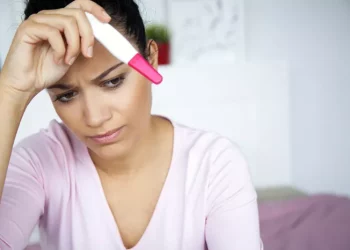Understanding the signs of ovulation is crucial for women trying to conceive. Ovulation, the release of a mature egg from the ovary, marks the peak of a woman’s fertility cycle. While ovulation typically occurs around the middle of a woman’s menstrual cycle, identifying its signs can help pinpoint the most fertile window for conception. In this comprehensive guide, we’ll delve into the seven key signs of ovulation, empowering women to recognize and leverage their body’s natural cues for achieving pregnancy.
1. Changes in Cervical Mucus:
One of the primary signs of ovulation is changes in cervical mucus. Throughout the menstrual cycle, cervical mucus undergoes distinct transformations influenced by hormonal fluctuations. Around ovulation, estrogen levels surge, causing cervical mucus to become clearer, thinner, and more slippery. This texture resembles the consistency of egg whites, facilitating sperm mobility and survival within the reproductive tract. Women can monitor these changes by observing the appearance and texture of cervical mucus daily. Using descriptive terms such as “stretchy,” “watery,” or “lubricative” can help in accurately identifying fertile cervical mucus.
2. Basal Body Temperature (BBT):
Tracking basal body temperature (BBT) is another effective method for detecting ovulation. BBT refers to the body’s lowest resting temperature, which typically occurs upon waking in the morning. After ovulation, a woman’s BBT tends to rise slightly, ranging from 0.5 to 1 degree Fahrenheit. This temperature shift is attributed to increased progesterone levels, which occur following ovulation and remain elevated throughout the luteal phase of the menstrual cycle. To accurately chart BBT patterns, women should use a basal body thermometer and record their daily temperatures upon waking before engaging in any physical activity or even speaking.
3. Ovulation Pain or Mittelschmerz:
Some women experience ovulation pain, also known as mittelschmerz, as a notable sign of ovulation. This mild abdominal or pelvic discomfort typically occurs on one side of the lower abdomen, corresponding to the ovary releasing an egg. Ovulation pain can vary in intensity, ranging from a dull ache to sharp twinges, and may last from a few minutes to several hours. While not all women experience mittelschmerz, those who do can use it as a reliable indicator of ovulation timing. Keeping a menstrual calendar and noting the onset and duration of ovulation pain can help predict future ovulatory cycles.
4. Changes in Cervical Position:
Observing changes in cervical position is another valuable method for identifying ovulation. The cervix, the lower part of the uterus, undergoes distinct changes in texture, position, and openness throughout the menstrual cycle. Around ovulation, the cervix becomes softer, higher, and more open to accommodate sperm entry into the uterus. Women can conduct cervical self-examinations by inserting a clean finger into the vagina to feel the cervix’s firmness, height, and opening. During ovulation, the cervix feels similar to touching the tip of a nose, indicating prime fertility.
5. Increased Libido:
Hormonal fluctuations during ovulation can significantly impact a woman’s libido, leading to increased sexual desire. Many women experience heightened arousal and libido around ovulation, driven by surges in estrogen and testosterone levels. This natural increase in sexual appetite serves as an evolutionary adaptation to maximize the chances of conception during the most fertile phase of the menstrual cycle. Recognizing changes in libido can help couples capitalize on peak fertility by engaging in sexual intercourse during this time.
6. Breast Tenderness or Sensitivity:
Breast tenderness or sensitivity is another common sign of impending ovulation for some women. Hormonal shifts, particularly increases in estrogen and progesterone, can cause breast tissue to swell, become tender, or feel sore. These changes typically occur in the days leading up to ovulation and may persist throughout the luteal phase of the menstrual cycle. While not all women experience breast tenderness as an ovulation sign, those who do can incorporate it into their fertility awareness routine. Wearing a supportive bra and avoiding caffeine can help alleviate discomfort associated with breast tenderness.
7. Ovulation Predictor Kits (OPKs):
For women seeking a more precise method of ovulation detection, ovulation predictor kits (OPKs) offer a convenient and reliable solution. OPKs detect the surge in luteinizing hormone (LH) that precedes ovulation, providing a clear indication of impending fertility. LH surge typically occurs 24 to 36 hours before ovulation, making it an ideal marker for timing intercourse for conception. To use OPKs effectively, women should follow the manufacturer’s instructions carefully, typically by testing urine samples daily around the anticipated ovulation window. OPKs are particularly useful for women with irregular menstrual cycles or those undergoing fertility treatments, offering valuable insights into their ovulatory patterns.
Conclusion:
Understanding the signs of ovulation empowers women to take control of their fertility journey and optimize their chances of conceiving. By recognizing subtle changes in cervical mucus, basal body temperature, ovulation pain, cervical position, libido, breast tenderness, and utilizing ovulation predictor kits, women can pinpoint their most fertile days with precision. Whether trying to conceive or simply monitoring reproductive health, being attuned to the body’s natural cues fosters a deeper connection to one’s fertility cycle. With knowledge and awareness, women can embark on their fertility journey with confidence and clarity.
Related Topics:
The Need for Pre Fertility Tests: A Complete Overview



























